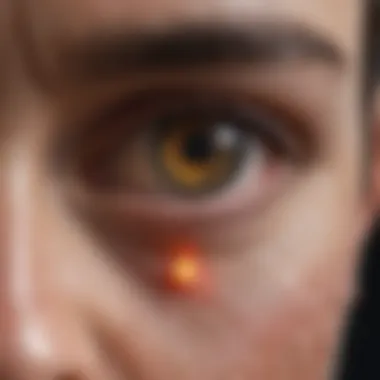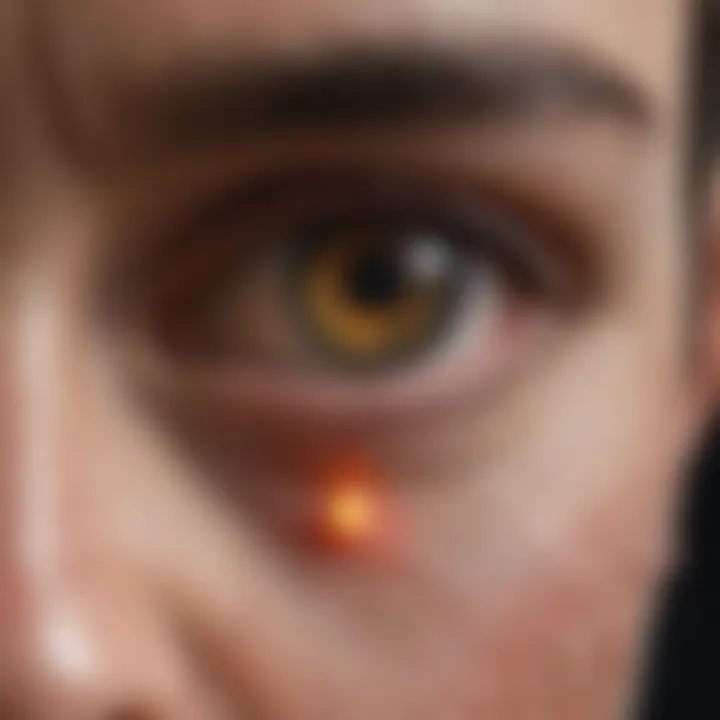Understanding Macula Disorders: Insights into Retinal Health


Intro
Macula disorders represent a significant health issue impacting the vision of millions worldwide. Understanding these conditions is critical as they often lead to irreversible visual loss. The macula, situated at the center of the retina, plays a vital role in our ability to see fine details and color. Disorders affecting this area can stem from various causes, including age, systemic diseases, and genetic factors.
Given the increasing prevalence of conditions like age-related macular degeneration and diabetic maculopathy, it is essential to explore the implications of these diseases on individual health and the broader healthcare system. This discussion will focus on the complexities of macula disorders, the latest developments in research and technology, and methods for diagnosis and treatment.
In providing a detailed examination of these issues, the goal is to enhance understanding among students, researchers, and healthcare professionals while emphasizing the importance of retinal health in overall well-being.
Recent Advances
Latest Discoveries
Recent advancements in the understanding of macula disorders have energized the field of ophthalmology. Research indicates a strong link between inflammation and the progression of age-related macular degeneration (AMD). Identifying inflammatory markers has opened the door to potential therapeutic targets, offering hope for more effective treatments. Furthermore, genetic research, particularly in identifying specific gene mutations associated with macular disorders, has made strides. These discoveries pave the way for personalized medicine approaches, allowing for tailored treatment based on an individual’s genetic profile.
Technological Innovations
The integration of technology in diagnosing and managing macula disorders has transformed patient care. Optical coherence tomography (OCT) is now a standard procedure, offering detailed images of the retina. This non-invasive imaging technique allows healthcare professionals to detect early signs of degeneration or damage in real-time. Additionally, artificial intelligence (AI) is beginning to play a role in analyzing retinal images, potentially improving early diagnosis accuracy and treatment planning.
“Technological innovations are revolutionizing the management of retinal health and are crucial for early detection of macular disorders.”
Methodology
Research Design
Current studies exploring macula disorders utilize a variety of research designs, including longitudinal studies that track changes in visual health over time. Many investigations focus on cohorts of individuals with specific conditions, such as AMD or diabetic retinopathy. Gathering data on demographic, lifestyle, and genetic factors helps researchers construct a comprehensive view of contributing elements.
Data Collection Techniques
Data collection in this field often employs a mixed-methods approach. Surveys and questionnaires assess the lifestyle factors influencing retinal health, while clinical assessments provide concrete data on visual acuity and retinal structure. Furthermore, genetic analyses are increasingly common, as researchers seek to link specific genetic variations with particular macula disorders.
The urgency to address macula disorders continues to grow. As our understanding of these conditions deepens and technology evolves, the capacity to enhance patient outcomes increases. Retinal health remains a crucial topic in public health, requiring ongoing attention from the academic and healthcare communities.
Prelude to Macula Disorders
Understanding macula disorders is fundamental to grasping the larger context of retinal health and its implications for vision. The macula, a small but vital part of the retina, is responsible for central vision, enabling tasks like reading and recognizing faces. When disorders affect this area, the consequences can be severe and often life-altering. This section shares insight into the significance of recognizing macular issues early, as well as their impact on quality of life.
Defining the Macula
The macula is a specialized part of the retina located near its center. It consists of tightly packed photoreceptor cells, primarily cones, which are crucial for color and detail perception. This region covers around 5mm in diameter and is responsible for high acuity vision. Any changes or damage to these cells can lead to vision impairments, which underlines the macula's importance in daily activities.
Importance of Macular Health
Maintaining healthy macula is essential for numerous reasons. First, it supports quality of life by ensuring clarity in vision. Loss of central vision can hinder daily activities and reduce independence. Second, various conditions can threaten macular health, including age-related macular degeneration and diabetic maculopathy. Recognizing the potential risks and symptoms early can lead to more effective management and treatment options. Regular eye examinations are therefore crucial, as they allow for monitoring and intervention before conditions progress.
"Understanding macula disorders is essential for preserving sight and ensuring a good quality of life for many individuals."
Common Types of Macula Disorders
Understanding the various types of macula disorders is essential in recognizing their impact on visual health. Each disorder has different implications and underlying causes, dictating unique approaches to diagnosis and treatment. As we delve into these conditions, it becomes clear how they significantly affect individuals' quality of life. Recognizing the symptoms and seeking timely intervention can greatly enhance management and outcomes.
Age-Related Macular Degeneration (AMD)
Age-Related Macular Degeneration (AMD) is a leading cause of vision loss among older adults. The condition primarily affects the macula, leading to distortion or loss of central vision. AMD is categorized into two types: dry and wet.
- Dry AMD is characterized by the thinning of macular tissue. Over time, this degeneration can cause gradual vision loss. People may notice that straight lines appear wavy or that colors seem less vibrant.
- Wet AMD occurs when abnormal blood vessels grow underneath the retina, leaking fluid and causing scarring. This type can lead to more significant and rapid vision loss.
The risk factors for AMD include age, family history, smoking, and diet. Early detection through eye examinations is critical since treatment options vary from lifestyle changes to advanced therapies.


Diabetic Maculopathy
Diabetic Maculopathy is a complication of diabetes that affects the retina. High blood glucose levels lead to damage of the blood vessels in the macula, resulting in swelling and leakage of fluids. Symptoms often include blurred or distorted vision. In some cases, individuals may not notice any significant changes until the condition has progressed.
Management includes maintaining stable blood sugar levels and regular eye exams. In advanced cases, treatments such as laser therapy or injections may be necessary to manage the leakage and help preserve vision.
Macula Hole
A macula hole is a small break in the macula that can lead to distorted or blurred central vision. This condition generally occurs due to aging, where the vitreous gel pulls away from the retina, causing a hole. Individuals with a macula hole may experience a dark spot in their central vision or both visual distortion.
Surgical intervention, specifically vitrectomy, is often the recommended treatment. During this procedure, the vitreous gel is removed, and a gas bubble is placed to help the retina heal and close the hole.
Macular Edema
Macular edema is characterized by the buildup of fluid in the macula, leading to swelling. This condition can result from various factors, including diabetic retinopathy or retinal vein occlusion. Symptoms may include blurry or distorted vision when reading or performing tasks that require sharp sight.
Treatment focuses on addressing the underlying cause. In diabetic macular edema, managing diabetes plays a crucial role. Options include corticosteroid injections, anti-VEGF therapy, or laser treatment to reduce fluid accumulation and improve vision.
It is crucial for individuals at risk to remain vigilant and consult with eye care professionals, as early intervention can be pivotal in preventing serious vision loss.
In summary, recognizing the types of macula disorders is essential in understanding their complex nature. Each condition has unique characteristics and treatment pathways, emphasizing the need for regular check-ups and awareness among at-risk populations.
Pathophysiology of Macula Disorders
Understanding the pathophysiology of macula disorders is crucial for grasping how these conditions develop and progress. The macula is a central part of the retina that is responsible for sharp, detailed vision. Disruptions to its cellular integrity can lead to significant visual impairments. Knowing the underlying biological mechanisms provides insights into potential therapeutic approaches and helps in identifying at-risk populations.
Cellular Changes in the Macula
Cellular alterations play a fundamental role in macula disorders. Various types of cells in the macula undergo changes in structure and function due to pathological processes. For example, retinal pigment epithelium (RPE) cells can become dysfunctional in age-related macular degeneration. This dysfunction leads to the accumulation of waste products, such as lipofuscin, contributing to cell death. Moreover, photoreceptor cells may deteriorate as they fail to receive proper support from RPE.
Alterations in the extracellular matrix also occur, which can affect cell adhesion and lead to further degeneration. Those cellular changes can impede the normal operation of the macula, thus culminating in loss of vision. Understanding these cellular dynamics is essential for developing therapies that can restore or protect macular function.
Role of Inflammation
Inflammation is another critical aspect in the pathophysiology of macula disorders. The immune response can initially serve protective functions, but when dysregulated, it may lead to chronic inflammation. This process is evident in conditions like diabetic maculopathy, where elevated blood sugar levels trigger inflammatory pathways.
In chronic inflammation, pro-inflammatory cytokines are released, which can damage macular cells. Inflammatory mediators alter the blood-retinal barrier, increasing vascular permeability and causing edema. This can result in further complications, such as macular swelling. Hence, understanding inflammation provides important avenues for treatment, such as the use of anti-inflammatory drugs that can mitigate tissue damage.
Genetic Factors Influencing Macular Disease
Genetic components have increasingly been recognized in the pathophysiology of macular disorders. Certain genetic mutations can predispose individuals to conditions like age-related macular degeneration and inherited retinal diseases. For instance, variants in genes such as CFH and ARMS2 have been linked to increased risk factors and disease progression for AMD.
In addition, the identification of specific genes can offer insights into family-related patterns of the disease. Genetic testing can aid in understanding an individual’s risk and inform clinical management strategies. It is discovered that modifiable environmental factors interacting with genetic predispositions can either exacerbate or delay the onset of macula disorders. Therefore, ongoing research into genetic factors is vital for developing personalized treatment approaches.
Studies show that understanding the pathophysiology can significantly improve the management of macula disorders.
Through a deeper understanding of cellular changes, inflammation, and genetic influences, professionals can better approach diagnosis and treatment. This understanding informs preventive strategies, ultimately benefiting retinal health.
Symptoms of Macula Disorders
Understanding the symptoms of macula disorders is essential as they provide critical insights into the overall health of the retina. These symptoms often serve as the first indicators of underlying conditions that could lead to significant visual impairment if not addressed in a timely manner. Without the ability to recognize and respond to these symptoms, patients may experience a reduced quality of life, often related to deteriorating vision.
Detecting symptoms early can aid in diagnosis and treatment, allowing healthcare professionals to implement appropriate interventions. This section delves into the common visual symptoms associated with macula disorders, alongside their implications for daily life and functionality.
Common Visual Symptoms
Individuals with macula disorders may experience a range of visual symptoms, which can vary in intensity and significance. Some of the most commonly reported symptoms include:


- Blurry vision: Blurriness often occurs in the central vision, which may hinder tasks such as reading or recognizing faces. In some instances, this can also affect distance vision.
- Distorted vision: This symptom is characterized by straight lines appearing wavy or bent. Patients may notice that objects look misshaped, leading to confusion in visual perception.
- Dark or empty areas in vision: Known as scotomas, these can manifest as dark patches or empty spaces in the line of sight, leading to difficulties in navigation or performing daily activities.
- Changes in color perception: Some individuals may find it challenging to identify colors accurately, notably losing the ability to differentiate darker shades.
Identifying these symptoms allows for prompt action, which can be pivotal in preventing further degeneration of vision. A person experiencing any combination of these symptoms should seek professional assessment without delay.
Impact on Daily Life and Functionality
Macula disorders do not just affect vision; they have profound effects on an individual’s daily life and overall functionality. The ability to see clearly is crucial for performing everyday tasks, such as driving, cooking, or using digital devices. Here are some notable impacts:
- Limitations in mobility: Difficulty in seeing can lead to challenges in moving around safely. This increases the likelihood of accidents and can foster an environment of dependency.
- Challenges in social interactions: Visual impairments can complicate personal interactions. Miscommunication and misunderstandings may arise due to difficulties in recognizing facial expressions or gestures.
- Reduced independence: Many individuals may find themselves needing assistance with activities they once managed independently. This loss can lead to feelings of frustration, anxiety, or depression.
- Increased risk of isolation: As vision deteriorates, individuals may withdraw from social situations, diminishing their quality of life. This isolation can also affect mental wellbeing, compounding the struggles of living with a visual disorder.
Understanding these impacts stresses the importance of recognizing symptoms early. Prompt treatment and effective coping strategies can significantly enhance quality of life for individuals affected by macula disorders.
"Awareness of symptoms can often be the difference between timely intervention and severe visual impairment."
Diagnosis of Macular Disorders
Diagnosing macular disorders is critical for effective management and treatment. Early diagnosis significantly improves the outcomes for patients suffering from macular conditions. This section outlines the significance of accurate diagnosis, discusses various examination methods, and highlights imaging techniques pivotal in the diagnosis of macular disorders.
Ophthalmic Examinations
Ophthalmic examinations are foundational to detecting any abnormalities in the macula. These assessments start with a comprehensive patient history, allowing eye care professionals to pinpoint risk factors, symptoms, and any relevant medical conditions. Key components include visual acuity tests, which gauge the sharpness of vision, and dilated eye exams, where eye drops widen the pupils to allow better visibility of the retina.
A thorough examination of the macula can reveal early signs of conditions like Age-Related Macular Degeneration or diabetic retinopathy. During these exams, an ophthalmologist may look for changes in coloration, drusens, or other irregularities in the retinal structure. Additionally, the use of tonometry helps measure intraocular pressure, which is essential to rule out glaucoma – a condition that can also affect retinal health.
Overall, such examinations provide valuable insights and are vital for developing a personalized management plan tailored to the patient's needs. Regular check-ups can lead to proactive care that mitigates the impact of these disorders on vision.
Imaging Techniques in Diagnosis
Advancements in imaging technology have revolutionized how macular disorders are diagnosed. Techniques like Optical Coherence Tomography (OCT) and Fundus Photography are becoming increasingly standard.
- Optical Coherence Tomography (OCT): This non-invasive imaging test captures high-resolution cross-sectional images of the retina. By providing layers of the macula in detail, OCT helps to identify the presence of fluid, thickening, or other anomalies. This information is invaluable in distinguishing various conditions, such as macular edema or a macula hole.
- Fundus Photography: High-resolution images of the retina are taken to document any changes over time. This technique is particularly beneficial for monitoring diabetic retinopathy's progression, enabling practitioners to evaluate the efficacy of treatments.
- Fluorescein Angiography: In this procedure, a dye is injected into the bloodstream to visualize the blood vessels in the retina. This method helps to detect leakages, blockages, or abnormalities that are not visible through standard examination methods.
It is essential to combine these imaging techniques with ophthalmic examinations for a comprehensive assessment of macular health.
Together, these diagnostic methods enhance the detection, monitor changes, aid in treatment planning, and facilitate a better understanding of the progression of macular disorders.
Current Treatment Options
The treatment landscape for macula disorders is intricate and evolving. Addressing these conditions effectively requires an understanding of varying strategies, as patient circumstances differ widely. Current treatment options are crucial not only for preserving vision but also for improving quality of life. This section will delve into three primary categories of treatments: pharmacological treatments, surgical interventions, and innovative therapies. Each category plays a significant role in managing macula disorders, and it is essential to be informed about their benefits and considerations.
Pharmacological Treatments
Pharmacological treatments are one of the first lines of defense against macula disorders. They typically involve the use of medications to slow progression or alleviate symptoms. For example, anti-vascular endothelial growth factor (anti-VEGF) injections are commonly used for conditions like age-related macular degeneration. These injections help to reduce abnormal blood vessel growth and leakage, thus preserving retinal health.
Other medications may also include corticosteroids, which can mitigate inflammation and reduce swelling in the macula. Patients often have to weigh the benefits of these medications against potential side effects. Side effects can range from mild irritation to more serious systemic reactions. Regular follow-ups with healthcare providers are important to monitor and adjust treatments as necessary.
Surgical Interventions
When pharmacological treatments do not suffice, surgical interventions can be considered. These procedures aim to address complex issues that arise with severe cases of macular disorders. Surgical options may include procedures such as vitrectomy, which involves removing vitreous gel from the eye. This can help alleviate symptoms caused by macular holes or significant hemorrhaging.
Another procedure, the macular translocation, involves repositioning the retina to a healthier part of the eye. It may offer benefits for certain patients with advanced degenerative conditions. Like all surgical options, these interventions come with risks, including complications like infection or retinal detachment. Therefore, careful assessment is needed to determine the appropriateness of surgery based on individual patient circumstances.
Innovative Therapies
Innovation in treatment options is at the forefront of research, offering hope for better outcomes for patients with macula disorders. Gene therapy represents a groundbreaking approach that aims to correct genetic defects at the root of specific macular diseases. While still in nascent stages, early trials have yielded promising results regarding improved vision.
Additionally, retinal implants and new drug delivery systems are being developed to enhance vision rehabilitation. These innovative therapies have the potential to change how macula disorders are treated in the future, providing options that are more tailored to individual patient needs.


It's essential for patients to discuss all available treatment options with healthcare professionals, considering both current and emerging therapies.
Preventive Measures and Lifestyle Considerations
Preventive measures and lifestyle considerations play a vital role in maintaining retinal health and mitigating the impact of macular disorders. Adopting healthy habits can significantly reduce the risk of developing these conditions and improve overall eye health. This section will explore the specific elements that support macular health, the benefits of these measures, and the important considerations related to lifestyle choices.
Nutritional Approaches
Diet fundamentally influences retinal health. Consuming a balanced diet rich in essential nutrients can fortify macular integrity. Key vitamins and minerals, particularly antioxidants, are crucial for protecting the retina from oxidative stress and inflammation.
- Leafy Greens: Kale, spinach, and collard greens are rich in lutein and zeaxanthin, carotenoids that filter harmful blue light.
- Fatty Fish: Salmon and sardines offer omega-3 fatty acids, which are linked to a lower risk of dry AMD.
- Berries: Blueberries and strawberries contain high levels of antioxidants, promoting overall retinal health.
- Nuts: Walnuts and almonds provide healthy fats and vitamin E, which may protect against age-related degeneration.
Incorporating these foods into daily meals can provide substantial benefits. However, it is equally important to limit processed foods, sugars, and unhealthy fats to support optimal health
Regular Eye Examinations
Monitoring eye health through regular examinations represents a critical aspect of preventive care. Eye exams allow for early detection of macular disorders, enhancing the chances of successful intervention.
- Frequency of Exams: Adults over 40 should undergo comprehensive eye exams every two years, increasing to annual examinations as they age or if risk factors develop.
- Visual Acuity Tests: Evaluate clarity of vision to detect changes.
- Dilated Eye Exams: Inspect the retina thoroughly for signs of macular illnesses.
- OCT Scans: Optical coherence tomography provides detailed images of the retinal layers, crucial for diagnosing macula conditions.
Regular check-ups can lead to timely and effective measures for managing prospective disorders.
Future Perspectives in Macula Disorder Research
As research into macula disorders continues to evolve, understanding future perspectives becomes crucial. This section provides insight into innovative treatments and the significance of genomic research in combating these retinal issues. By exploring these future directions, we can better forecast the potential shifts in management and therapeutic strategies, thus improving patient outcomes.
Emerging Treatments and Technologies
The landscape of emerging treatments for macula disorders is rapidly changing. One area of significant promise is the development of biologics. These are engineered molecules that can precisely target the underlying mechanisms causing disorders like age-related macular degeneration. For instance, anti-VEGF (vascular endothelial growth factor) therapies have already demonstrated efficacy in treating wet AMD, and future iterations may offer extended release options that improve patient compliance.
Furthermore, advancements in gene therapy are stirring excitement. This pathway allows for the direct correction of genetic aberrations that lead to macular diseases. Clinical trials using approaches such as AAV (adeno-associated virus) vectors are ongoing, aiming to restore normal function in retinal cells impaired by genetic defects. The potential for gene therapy to provide durable and possibly curative solutions shifts how macula disorders are viewed in terms of treatment.
Another promising area is the integration of digital health technologies. These include the use of telemedicine and mobile applications that allow for early detection and regular monitoring. Patients can conduct home measurements of visual function, enabling timely interventions and continuous evaluation of treatment effectiveness.
The convergence of innovative treatments and technology signifies a transformative era in managing macula disorders.
Genomic Research and Implications
Genomic research is becoming increasingly vital in understanding macula disorders. By examining genetic predispositions, researchers can identify individuals at higher risk of developing conditions like diabetic maculopathy or AMD. This knowledge aids in risk stratification, potentially leading to personalized treatment approaches.
A significant example includes the role of single-nucleotide polymorphisms (SNPs) in AMD. Identifying these genetic markers may help tailor preventive strategies and management plans unique to each patient. With increasing understanding of the genetic underpinnings, it opens doors for precision medicine, an approach that uses genetic information to guide treatment decisions.
Moreover, there are ethical considerations surrounding the use of genomic information that must be navigated carefully. Issues regarding patient consent, data privacy, and the potential for genetic discrimination need to be addressed as genomic data becomes a cornerstone in understanding macula disorders.
In summary, both emerging treatments and genomic research carry tremendous potential for reshaping the future of macula disorder management. The synergy between advancements in medical science and technology heralds an era where treatment can be more targeted, effective, and responsive to individual patient needs.
Ending
The conclusion serves as a pivotal component of this article on macula disorders. It encapsulates the various discussions presented throughout. As readers reach this section, they should have developed a comprehensive understanding of the complexity of macular health. By outlining key elements, the conclusion reiterates the importance of awareness regarding these disorders, their implications for vision, and measures to maintain retinal health.
Summary of Key Points
The article begins by defining the macula and emphasizing its significance to overall vision and eye health. Key points include:
- Types of Disorders: Age-related macular degeneration, diabetic maculopathy, macula hole, and macular edema represent common macular conditions with varied pathophysiology.
- Symptoms and Diagnosis: Recognizing the symptoms is crucial for timely diagnosis. Various ophthalmic examinations and imaging techniques are highlighted as necessary steps for proper assessment.
- Treatment Options: Current treatment options range from pharmacological approaches to surgical interventions. Innovative therapies aim to enhance patient outcomes.
- Preventive Measures: Nutritional approaches and regular eye examinations play a critical role in maintaining macular health and preventing disorders.
- Future Directions: Insights into emerging treatments and genomic research underline the ongoing quest for better understanding and care in retinal health.
By summarizing these themes, the conclusion reinforces the complexity and significance of macula disorders and their management.
Call for Increased Awareness and Research Support
In light of the critical information presented, it is vital to call for increased awareness and support for research on macular health. Education regarding the risks and symptoms of macular disorders could lead to earlier diagnosis and treatment, ultimately preserving vision.
"Greater awareness in the community can result in more individuals seeking regular eye examinations or making lifestyle changes that could mitigate risks."
Moreover, funding for research into new therapies and technologies is essential. As we understand more about genetic factors and pathophysiological processes, developing targeted treatments will become more feasible. Engaging academic institutions, healthcare providers, and funding bodies in this dialogue can improve patient outcomes significantly.















